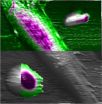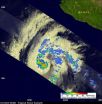(Press-News.org) CHICAGO --- Following a major Northwestern Medicine breakthrough that identified a common converging point for all forms of amyotrophic lateral sclerosis (ALS and Lou Gehrig's disease), a new finding from the same scientists further broadens the understanding of why cells in the brain and spinal cord degenerate in the fatal disease.
Less than three months ago, Northwestern research found that the crucial recycling system for cells in the brain and spinal cord was broken in people with ALS. And one mutated gene had a key role. Like a loafing worker, it wasn't doing its job to recycle damaged cells.
Now, scientists have discovered a second faulty gene -- a new loafing worker -- in the same recycling pathway. The finding is reported in Archives of Neurology.
"Now that we have two bad players, it shines more light on this broken pathway," said senior author Teepu Siddique, M.D., the Les Turner ALS Foundation/Herbert C. Wenske Professor of the Davee Department of Neurology and Clinical Neurosciences at Northwestern's Feinberg School and a neurologist at Northwestern Memorial Hospital. "This gives us a clear target to develop drug therapies to try to fix this problem. It strengthens our belief that this broken system is at the heart of ALS."
The new "bad player" is called sequestosome1. The previously identified mutated gene is ubiquilin2. Because these two genes aren't doing their jobs to recycle damaged proteins, those proteins – as well as sequestosome1 and ubiquilin2 -- accumulate abnormally in the motor neurons in the spinal cord and cortical and hippocampal neurons in the brain. The protein accumulations resemble twisted skeins of yarn -- characteristic of ALS -- and cause the degeneration of the neurons.
In the new study, sequestosome1 genetic mutations were identified in 546 ALS patients; 340 with an inherited form of the disease, called familial, and 206 with a non-inherited form of the disease, called sporadic.
About 90 percent of ALS is sporadic and 10 percent is familial. To date, mutations in about 10 genes, several of which were discovered at Northwestern, including SOD1 and ALSIN, account for about 30 percent of classic familial ALS, noted Faisal Fecto, M.D., study lead author and a PhD candidate in neuroscience at Feinberg.
ALS affects an estimated 350,000 people worldwide, including children and adults, with about 50 percent of people dying within three years of its onset. In the motor disease, people progressively lose muscle strength until they become paralyzed and can no longer move, speak, swallow and breathe. ALS/dementia targets the frontal and temporal lobes of the brain, affecting patients' judgment, the ability to understand language and to perform basic tasks like planning what to wear or organizing their day.
The discovery of the breakdown in protein recycling may also have a wider role in other neurodegenerative diseases, particularly the dementias. These include Alzheimer's disease and frontotemporal dementia as well as Parkinson's disease, all of which are characterized by aggregations of proteins, Siddique said. The removal of damaged or misfolded proteins is critical for optimal cell functioning, he noted.
###The study was supported by the National Institute of Neurological Disorders and Stroke, the Les Turner ALS Foundation, the Herbert and Florence C. Wenske Foundation and other sources.
New culprit found in Lou Gehrig's disease
A second 'bad' gene is linked to damaged cell buildup, paralysis in ALS
2011-11-22
ELSE PRESS RELEASES FROM THIS DATE:
Van Andel Institute study may lead to better, safer drug for diabetes
2011-11-22
Grand Rapids, Mich. (November 21, 2011) A Van Andel Research Institute (VARI) study published recently in the Journal of Biological Chemistry reveals that a natural fatty acid can serve as a regulator of blood sugar levels, which may have important applications in designing better and safer drugs for diabetes treatment.
According to the U.S. Center for Disease Control and Prevention (CDC), nearly 26 million Americans have diabetes, and current drugs commonly used to treat the disease sometimes have unwanted side effects.
The study found that decanoic acid, a saturated ...
New projection shows global food demand doubling by 2050
2011-11-22
Global food demand could double by 2050, according to a new projection by David Tilman, Regents Professor of Ecology in the University of Minnesota's College of Biological Sciences, and colleagues, including Jason Hill, assistant professor in the College of Food, Agricultural and Natural Resource Sciences.
Producing that amount of food could significantly increase levels of carbon dioxide and nitrogen in the environment and cause the extinction of numerous species. But this can be avoided, the paper shows, if the high-yielding technologies of rich nations are adapted ...
New medical, research tool possible by probing cell mechanics
2011-11-22
WEST LAFAYETTE, Ind. - Researchers are making progress in developing a system that measures the mechanical properties of living cells, a technology that could be used to diagnose human disease and better understand biological processes.
The team used an instrument called an atomic force microscope to study three distinctly different types of cells to demonstrate the method's potentially broad applications, said Arvind Raman, a Purdue University professor of mechanical engineering.
For example, the technique could be used to study how cells adhere to tissues, which is ...
Future prostate cancer treatments might be guided by math
2011-11-22
COLUMBUS, Ohio – Scientists have designed a first draft of a mathematical model that someday could guide treatment decisions for advanced prostate cancer, in part by helping doctors predict how individual patients will respond to therapy based on the biology of their tumors.
These decisions would apply to treatment of cancer that has already spread beyond the prostate gland or that has recurred after initial treatments, such as surgery or radiation. Patients with this more advanced prostate cancer receive a therapy called androgen ablation, which inhibits production of ...
Use of technology-rich learning environment reveals improved retention rates
2011-11-22
Researchers at Rochester Institute of Technology have found that use of a technology-rich learning environment in several undergraduate engineering-technology courses has improved learning and decreased withdrawals from, or failing grades in, the courses.
They found that more than 90 percent of students involved stated that using the technology-rich environment—which includes a combination of tablet PCs, collaborative software, and multiple projection screens capable of capturing and retaining graphics and notations—helped them learn and retain the information better ...
Life-threatening condition in preemies linked to blood type
2011-11-22
MAYWOOD, Ill. -- Many premature infants suffer a life-threatening destruction of intestinal tissue called necrotizing enterocolitis (NEC).
Now a Loyola University Medical Center study has identified a major risk factor for NEC: Preemies with the AB blood type who develop NEC are nearly three times as likely to die from it as preemies with other blood types.
The finding suggests that a simple change in blood transfusion practices in neonatal ICUs could significantly reduce the incidence of NEC.
The study is published online ahead of print in the Journal of Perinatology. ...
Canadian breast cancer screening guidelines would cost thousands of lives
2011-11-22
The American College of Radiology today denounced new breast cancer screening guidelines by the Canadian Task Force on Preventive Health (CTFOPH), which recommend against annual screening of women ages 40-49 and would extend time between screens for older women.
An ACR news release said "the CTFOPH guidelines ignore results of recent landmark randomized control trials which show that regular screening reduces breast cancer deaths in these women by approximately a third" and that "While implementation of the CTFOPH guidelines may save money on screening costs, the result ...
KLAS Offers Providers New Pharmacy-Focused Research
2011-11-22
Healthcare research firm KLAS announces a new pharmacy report designed to help providers attending the 2011 American Society of Health-System Pharmacists (ASHP) conference make informed pharmacy technology buying decisions. With thinning wallets, providers are becoming more strategic in their technology purchasing decisions--and pharmacy is no exception.
The "KLAS Pharmacy Buyers Guide" offers product ratings for more than 100 software and equipment offerings, all based on the feedback of thousands of healthcare providers. Each rated product has been given ...
Late season Hurricane Kenneth forms in the eastern Pacific
2011-11-22
The hurricane season in the eastern Pacific isn't over and Hurricane Kenneth serves as a reminder that the season ends November 30. NASA satellite imagery shows Kenneth more organized than it appeared on Sunday, Nov. 20 and became a late season hurricane earlier today.
Kenneth began as the thirteenth tropical depression and that formed on Saturday, November 19, about 480 miles south of Acapulco, Mexico. On Sunday, November 29 at 0300 UTC (11 p.m. EST, Nov. 19) the National Hurricane Center noted that the center of Tropical Depression 13E was further north than previously ...
All systems go for next communication spacecraft
2011-11-22
The most recent evaluations of NASA's Tracking and Data Relay Satellite (TDRS) project confirmed all systems go for a third generation upgrade of the orbiting communications network. TDRS-K is scheduled for launch aboard an Atlas V rocket from Cape Canaveral, Florida in the fall of 2012.
Approval to move forward came during a recent Agency Project Management Council (APMC) meeting at NASA Headquarters. "I am very proud of the entire TDRS civil servant and contractor team for successfully completing this milestone and demonstrating that the TDRS project is ready to proceed ...
LAST 30 PRESS RELEASES:
Interaction of climate change and human activity and its impact on plant diversity in Qinghai-Tibet plateau
From addressing uncertainty to national strategy: an interpretation of Professor Lim Siong Guan’s views
Clinical trials on AI language model use in digestive healthcare
Scientists improve robotic visual–inertial trajectory localization accuracy using cross-modal interaction and selection techniques
Correlation between cancer cachexia and immune-related adverse events in HCC
Human adipose tissue: a new source for functional organoids
Metro lines double as freight highways during off-peak hours, Beijing study shows
Biomedical functions and applications of nanomaterials in tumor diagnosis and treatment: perspectives from ophthalmic oncology
3D imaging unveils how passivation improves perovskite solar cell performance
Enriching framework Al sites in 8-membered rings of Cu-SSZ-39 zeolite to enhance low-temperature ammonia selective catalytic reduction performance
AI-powered RNA drug development: a new frontier in therapeutics
Decoupling the HOR enhancement on PtRu: Dynamically matching interfacial water to reaction coordinates
Sulfur isn’t poisonous when it synergistically acts with phosphine in olefins hydroformylation
URI researchers uncover molecular mechanisms behind speciation in corals
Chitin based carbon aerogel offers a cleaner way to store thermal energy
Tracing hidden sources of nitrate pollution in rapidly changing rural urban landscapes
Viruses on plastic pollution may quietly accelerate the spread of antibiotic resistance
Three UH Rainbow Babies & Children’s faculty elected to prestigious American Pediatric Society
Tunnel resilience models unveiled to aid post-earthquake recovery
Satellite communication systems: the future of 5G/6G connectivity
Space computing power networks: a new frontier for satellite technologies
Experiments advance potential of protein that makes hydrogen sulfide as a therapeutic target for Alzheimer’s disease
Examining private equity’s role in fertility care
Current Molecular Pharmacology achieves a landmark: real-time CiteScore advances to 7.2
Skeletal muscle epigenetic clocks developed using postmortem tissue from an Asian population
Estimating unemployment rates with social media data
Climate policies can backfire by eroding “green” values, study finds
Too much screen time too soon? A*STAR study links infant screen exposure to brain changes and teen anxiety
Global psychiatry mourns Professor Dan Stein, visionary who transformed mental health science across Africa and beyond
KIST develops eco-friendly palladium recovery technology to safeguard resource security
[Press-News.org] New culprit found in Lou Gehrig's diseaseA second 'bad' gene is linked to damaged cell buildup, paralysis in ALS



